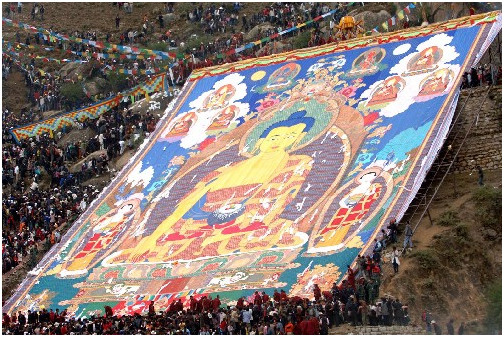This is an introduction of festivals in Tibet.
Tibetan New Year
Tibetan New Year is the most important festival in Tibet. It is an occasion when Tibetan families reunite and expect that the coming year will be a better one. Known as Losar, the festival starts from the first to the third day of the first Tibetan month. Preparations for the festive event are manifested by special offerings to family shrine deities, painted doors with religious symbols, and other painstaking jobs done to prepare for the event. Tibetans eat Guthuk (barley crumb food with filling) on New Year’s Eve with their families. Eating Guthuk is fun since the barley crumbs are stuffed with a different filling to fool someone in the family. The Festival of Banishing Evil Sprits is observed after dinner. Signs that the New Year is approaching when one sees lit torches, and people running and yelling to get rid of evil spirits from their houses. Before dawn on New Year’s Day, housewives get their first buckets of water for their homes and prepare breakfast. After breakfast, people dress up to go to monasteries and offer their prayers. People visit their neighborhoods and exchange their Tashi Delek blessings in the first two days. Feast is the theme during the occasion. On the third day, old prayer flags are replaced with new ones. Other folk activities may be held in some areas to celebrate the events.
Shoton Festival
Shoton Festival, also known as the Yoghurt Festival, begins on the thirtieth day of the sixth Tibetan month. The origin of the festival started from the 17th century when pilgrims served yoghurt to the monks who stopped for their summer retreat. Years later, Tibetan opera performances were added to the event to amuse monks in monasteries. During the festival, giant Thangkas of the Buddha are unveiled in Drepung Monastery while Tibetan opera troupes perform at Norbulingka.
Bathing Festival
The Bathing Festival starts on the twenty-seventh day of the seventh lunar month and lasts a week when Venus appears in the sky. Tibetans bring food, set up tents along rivers and bathe themselves under the star light. The holy bath was believed to heal all kinds of illnesses and wards off misfortune.
Gyangtse Horse Race Festival
There are different versions of the origin of Gyangtse Horse Race Festival, which is also popular throughout Tibet. The festival usually falls in June. Horse race, archery contest, and other games are performed to entertain people. Religious activities also are part of the event.
Nakchu Horse Race Festival
Nakchu Horse Race Festival is the most important folk festival in Tibet. People who gather for the annual horse race festival in Nakchu town construct a tent city. Dressing themselves and their finest horse, thousands of herdsmen participate in the thrilling horse race, archery and horsemanship contest. Other folk activities and commodity fairs are also held. The event falls on early August.
kungbu traditional festival(november or december)
Long time ago, when tibet was in danger of large scale invasion. the kungbu people sent out an army to defend their homeland. it was in september and the soilders worried thet they might miss the new year, highland barely wine and other good things. so people had the tibet new year on 1st october ahead of time. to memorise those brave soilders kungbu people present three sacrificesand stay up at night from then on. and now I thas becomes the kungbu festival for entertainment like kungbu dancing,horse race,archery and shooting.
Harvest Festival
Harvest Festival (Ongkor in Tibetan) is celebrated when crops ripen, usually around August. The festival is observed only in farming villages. People walk around their fields to thank the gods and deities for a good year’s harvest. Singing, dancing, and horseracing are indispensable folk activities.
Saka Dawa Festival
On the fifteenth day of the fourth Tibetan month is Saka Dawa Festival. The day is believed to be the time when Sakyamuni was born; stepped into Buddhahood, and attained nirvana. Tibetans believe that a merit is an accumulation of a myriad of merits from previous days, months or years. People refrain from killing animals by liberating them and abstain from eating meats. Sutra chanting, prayer turning, Cham dancing and other religious activities dominate the occasion. Offering sacrifices to the female deity enshrined in the temple on the islet of the Dragon King Pond, boating in the pond and picnicking add more to the festive mood.
The Monlam Prayer Festival
The Monlam Prayer Festival follows it in the first month of the Tibetan calendar, falling on the fourth up to the eleventh day of the first Tibetan month, which involves many Tibetans dancing and participating in sports events and sharing picnics. The event was established in 1049 by Tsong Khapa, the founder of the Dalai Lama and the Panchen Lama’s order.
The Butter Lamp Festival
The Butter Lamp Festival is celebrated on the 15th day of the first month every year by the Tibetan in Qinghai and Gansu provinces. It ‘s the last day of the Great Prayer Festival. To honor the victory of Sakyamuni in a debate against Heretics,people assemble at the Barkhor Street in Lhasa, worshiping the Buddha in the daytime and by nightfall. People usually light thousands of lamps filled with butter in an intriguing assortment of designs including immortals, animals, flying birds, beasts, and flowers. The whole festive will last all night. People sing and dance in great joy throughout the night.
